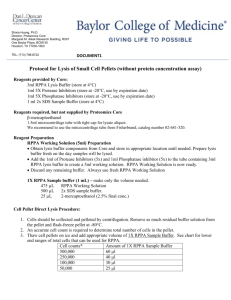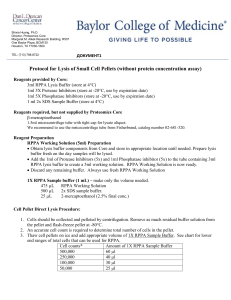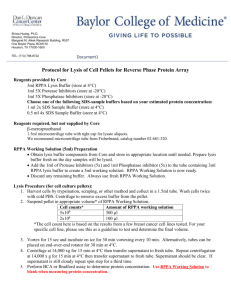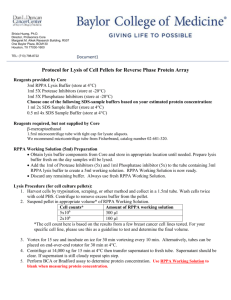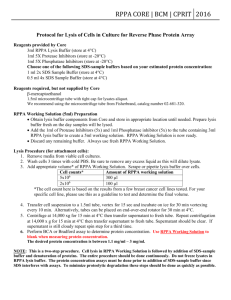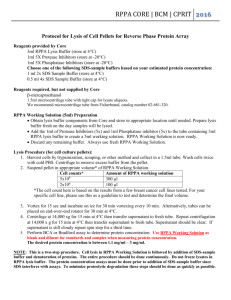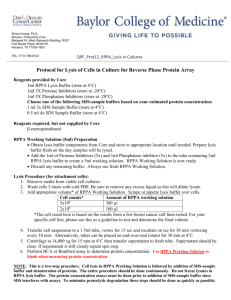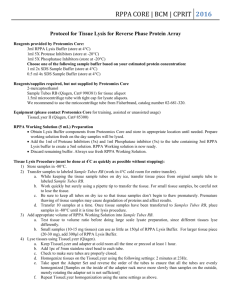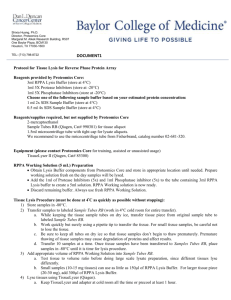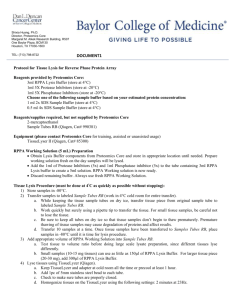RPPA CORE | BCM | CPRIT
advertisement
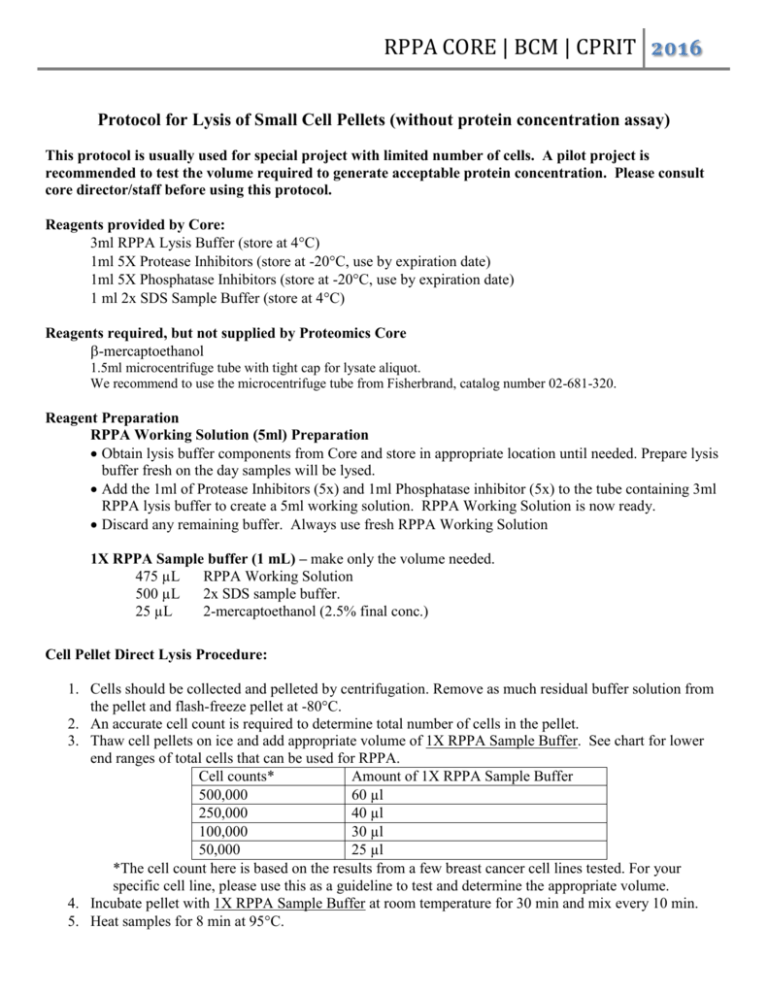
RPPA CORE | BCM | CPRIT 2016 Protocol for Lysis of Small Cell Pellets (without protein concentration assay) This protocol is usually used for special project with limited number of cells. A pilot project is recommended to test the volume required to generate acceptable protein concentration. Please consult core director/staff before using this protocol. Reagents provided by Core: 3ml RPPA Lysis Buffer (store at 4C) 1ml 5X Protease Inhibitors (store at -20C, use by expiration date) 1ml 5X Phosphatase Inhibitors (store at -20C, use by expiration date) 1 ml 2x SDS Sample Buffer (store at 4C) Reagents required, but not supplied by Proteomics Core -mercaptoethanol 1.5ml microcentrifuge tube with tight cap for lysate aliquot. We recommend to use the microcentrifuge tube from Fisherbrand, catalog number 02-681-320. Reagent Preparation RPPA Working Solution (5ml) Preparation Obtain lysis buffer components from Core and store in appropriate location until needed. Prepare lysis buffer fresh on the day samples will be lysed. Add the 1ml of Protease Inhibitors (5x) and 1ml Phosphatase inhibitor (5x) to the tube containing 3ml RPPA lysis buffer to create a 5ml working solution. RPPA Working Solution is now ready. Discard any remaining buffer. Always use fresh RPPA Working Solution 1X RPPA Sample buffer (1 mL) – make only the volume needed. 475 µL RPPA Working Solution 500 µL 2x SDS sample buffer. 25 µL 2-mercaptoethanol (2.5% final conc.) Cell Pellet Direct Lysis Procedure: 1. Cells should be collected and pelleted by centrifugation. Remove as much residual buffer solution from the pellet and flash-freeze pellet at -80°C. 2. An accurate cell count is required to determine total number of cells in the pellet. 3. Thaw cell pellets on ice and add appropriate volume of 1X RPPA Sample Buffer. See chart for lower end ranges of total cells that can be used for RPPA. Cell counts* Amount of 1X RPPA Sample Buffer 500,000 60 µl 250,000 40 µl 100,000 30 µl 50,000 25 µl *The cell count here is based on the results from a few breast cancer cell lines tested. For your specific cell line, please use this as a guideline to test and determine the appropriate volume. 4. Incubate pellet with 1X RPPA Sample Buffer at room temperature for 30 min and mix every 10 min. 5. Heat samples for 8 min at 95C. 6. Spin at 14,000 xg for 15 min at room temperature then transfer supernatant to fresh tube. Repeat centrifugation at 14,000 x g for 15 min at room temperature then transfer supernatant to fresh tube. Record your total volume. If the supernatant is sticky or hard to collect at the above steps, add an extra 5-10µl 1X RPPA Sample Buffer before spinning. 7. Supernatant should be clear. If supernatant is cloudy, please repeat the above spin step until supernatant is clear. 8. Please consult core director for specific project needs if the volume is too low. Otherwise, transfer supernatant into 1 tube and indicate volume in the tube and in the sample submission form (please use 1.5ml microcentrifuge tube with tight cap to avoid sample loss during heating). 9. Clearly label sample tubes and put them into a freezer/cardboard box labeled with your name/PI name, contact number/date etc. Label top of the tube as follows: PI initials_Auto# (ex: SH_1) SH_1 RPPA-__ul Label freezer/cardboard box as follows: Investigator Name/PI name Contact number Date 10. Store at -80°C until submission. 11. Send your RPPA_Sample Submission Form by email before you deliver your samples to the Core. *DO NOT use homemade or any other concentration of SDS Sample Buffer as they have not been validated for this platform.
